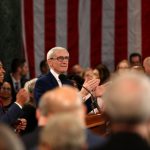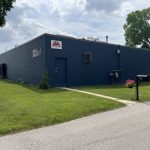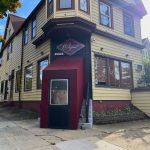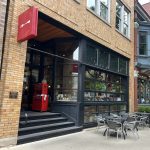2003
June Carter Cash
By Brian Barney JUNE CARTER CASH Wildwood Flower Dualtone Records The heartbreaking beauty of June Carter Cash’s last record, Wildwood Flower, defies description. The tracks flow in an autobiographical movement, where the purest of instrumentation provides the background for songs that tell the stories of a life based on tradition, and values that escape the trappings of politics and trend. The CD is an obvious final testament to her 2002 visit to her parents’ home in Virginia, where she sat on the back porch, singing family classics with husband Johnny, and her cousins, Janette and Joe Carter. What followed was a two day recording session producing 14 songs, eight of which are heard on Wildwood Flower. Opening track “Keep on the Sunny Side” sets the tone with rich, full bodied, piercingly bright 6-strings that provide accompaniment to her voice which, while somewhat quavering, resonates with as much strength and emotion as the version recorded by her late mother on the Nitty Gritty Dirt Band’s Will The Circle Be Unbroken. The enchantment continues throughout with gut-wrenchers like “Storms Are On The Ocean” with its’ string arrangements so achingly beautiful that…well…let’s just say, it could set a grown man to weepin’. There is also an air of fun and abandon in tracks like “Temptation,” and snippets of conversation between June and family spanning time from early Opry days to the current sessions. Standout tracks featuring flat top at its’ best can be found in “Alcatraz” and “Cannonball Blues,” while gospel meant for hand holding and praise is displayed in classics like “Anchored in Love.” The Carter/Cash coalition has long been considered by many to be the most important and influential contribution to Americana and country music ever, and proof of that is certainly found in this must-have record.
Oct 1st, 2003 by Vital ArchivesA Dance of Survival & Freedom
By Alexander Ragir In the 17th century, African slaves in Salvador (Brazil’s oldest city) were routinely shackled and beaten. But those slaves of 400 years ago were not as beaten down as they may have appeared to their Portuguese slave masters. Always coming up with ways to survive their oppressors, the slaves practiced combat moves under the guise of a dance, and taught one another how to fight. When you watch Capoeira dancers/athletes in action it’s easy to see how those 17th-century slaves from Angola outwitted their masters: the purpose is to avoid aggressive movements, instead relying on stealth. The martial art was outlawed until the 1930s in Brazil; now you see it everywhere in the city of Salvador. Salvador was the second most important city in the Portuguese empire after Lisbon, and the center of the sugar trade. The city is said to be the most “African” place outside of Africa. It is also one of the poorest places in Brazil. The old city of Salvador, Pelorinho (meaning “whipping post”), was formerly the home to Bahian aristocrats and its cultural elite. Descending from the baroque architecture — gold-filled churches and beautiful mansions at the top of the hillside — are steep, twisty cobblestone roads paved by the hands of slaves. Four centuries later my North American friend, Joey, and I drank in the same breathtaking view overlooking the plaza below. A man approached us, spreading arms colored with beaded necklaces in the shape of a berimbau, the principal instrument of Capoeira and proclaimed, “Amigo!” He went on to inform us that 10 necklaces for three reals (90 cents) is a good deal, because all the Bahian women love them. Today, Pelorinho is restored for tourists and packed with restaurants, bars, art galleries and boutiques. The architecture is wealthy 17th-century Portuguese, while the culture is more African or Jamaican than South American. The relationship between past and present in Pelorinho is striking; understanding it, elusive. Survival on the streets. The spirit of Salvador is belied by smiles and overfriendliness that lend a superficial air of gaiety, but its true theme is survival. Whether being befriended by a stranger, seduced by a woman or being invited to participate in a Capoeira performance, tourists will be asked for money afterward. Native Salvadoran culture was developed through a struggle to survive as slaves. Now, the spirit of survival embedded into that culture dips into the hearts and pockets of tourists. Begging in Salvador is endemic. If you do not completely ignore the beggars, you will be surrounded with palms-up. For many in Salvador, one American dollar is equivalent to one day’s work at minimum wage. We had arrived that morning from the red-eye, an 11-hour bus ride from Puerto Seguro, and were waiting on the front steps of what is now the Jorge Amado Museum. It was to reopen after the midday siesta. The humid heat made it hard to breathe. As we sat on the steps, the man with necklaces tried new […]
Oct 1st, 2003 by Vital ArchivesOh My God
By Brian Barney OH MY GOD Interrogations and Confessions Novo Records www.ohmygodmusic.com Since their reincarnation under their current moniker in 2000, Chicago’s art rock trio, Oh My God has been creating a national buzz, prompting kudos from the likes of VH1 and Rolling Stone Magazine without the support of a major label. Their third full-length release, Interrogations and Confessions, is another step upward in this highly original band’s climb to the top. No guitars needed here, as the keyboard genius of Iguana brings on a Leslie-driven tidal wave that drenches the listener with an erratic, quirky smoothness showing a flip side that has more muscle than any stack of Marshalls can muster. Lead singer/bass player (and Milwaukee native) Billy O’Neill fronts with a theatrical flare and a voice that has Sinatra’s smoothness with the edginess of Bono at his best. Newest addition, Bish, holds things together with a drumming style that leaves the novices awed and experts impressed. The disc is a bit of a departure, with a few tracks that seem to creep toward the fringes of the mainstream. Cuts like “Our Loves” and “Shine,” show radio friendliness, while the driving, almost ballad-like beauty of “February 14” (in this writer’s opinion, the record’s high point) has a flavor that could easily be described as national. For those of you who have come to love the band for its’ eclectic and “artsy” side, don’t despair; songs like “Tom” and “Rat Man’s Confession” along with the bicep flexing drive of “Volatile” and “Get Steady” will leave you with plenty to chew on. In a recent interview, Iguana talked about their struggles on the road. “We played 114 shows last year covering both coasts, and only had a hotel twice. Hard touring has caused us to look inward” he stated. The boys seem to have done just that, coming up with yet another body of work that is as unpredictable as it is accessible. There is no filler on this album. Like all their prior work, OMG’s latest is a work of art.
Oct 1st, 2003 by Vital ArchivesIn Search of An Agenda
By John Hughes Early next year, The City of Milwaukee will elect a new mayor, to preside over this city during what promises to be an era of accelerating change. With leadership crucial during the next few years, the agenda set during this election, which will frame the debate among voters, is still emerging. In our September issue, Vital Source put four questions to four mayoral candidates: Tom Barrett, Sandy Folaron, Martin Matson, and John Pitta. We believe the candidates’ answers to these questions reflect some of the leadership style which they would exhibit if elected. Already, the landscape is shifting. Pedro Colon is out. Rumors abound that the big money is hiding in the wings until David Clarke decides whether or not he will run. Others are rumored to be shopping their potential amongst the fundraising set. We shall see what the coming months bring. For this issue, we contacted candidates Frank Cumberbatch and Tom Nardelli. Marvin Pratt and Vincent Bobot are expected to reply for the November issue of Vital Source. Frank Cumberbatch has been Project Manager for the Waukesha County Department of Information Systems, Milwaukee Director of Service Delivery for Kedestra, a real estate e-commerce company, President of the Board of Directors of the Latino Community Center, and Executive Secretary of the Community Brainstorming Conference, among numerous other professional and community service achievements. Tom Nardelli has served Milwaukee for 16 years as a member of the Common Council as Alderman for the 15th District. He currently chairs the Common Council’s Public Safety Committee and serves as a member of the Economic Development and the Steering and Rules Committees. He is a member of the Board of Directors for the Wisconsin Center District; owners and operators of the Midwest Express Center, U. S. Cellular Arena and the soon to be renovated Milwaukee Auditorium. He chairs the District’s Project Development Committee. He is a member of the board for the Milwaukee Economic Development Corporation (MEDC) and a member of the MEDC Land Committee. 1. VITAL SOURCE: What specific steps will you take to make the police chief more accountable to the people of Milwaukee? Frank Cumberbatch: I will ask the police chief to submit a detailed plan for improving the relationship between the police department and city neighborhoods, especially high crime areas. I will also ask constituents, through surveys, to grade the performance of the police department in the following categories: crime prevention; response to calls; building trust; treatment of witnesses, suspects and victims; visibility and race relations. The survey results and the effectiveness of the plan will count heavily toward the chief’s overall job performance evaluation. Tom Nardelli: It will be my intent to have a good working relationship with whomever is selected to be the new police chief. State law gives the Chief considerable independent power from those who would attempt to politically persuade him/her to do their bidding. Under that State law, the Chief is solely responsible to ensure the public safety. I do believe that […]
Oct 1st, 2003 by Vital ArchivesMilwaukee’s Philosopher Magician
By John Hughes Meet ‘Professor Oops’ On the Sunday afternoon of the Harley-Davidson centenary, with motorcycles thundering all over town, I found a quiet spot in the side yard of Sky Schultz, known to audiences as Professor Oops. At his Riverwest home tucked into an out-of-the-way cranny, the yard is a thing of wonder — enchanted by the presence of well over 100 potted plants, a dozen birdhouses, a small statue and a tree swing. With trees draping their green canopy over us, and Sky speaking in a hushed, thoughtful tone, peace and quiet made their shy return. Sky Schultz, 62, has a Ph.D. in Clinical Psychology. He says of his training, “They never told us we’re all insane. They never taught us to sit down and watch how our own minds work. Mark Twain said, ‘When you realize we’re all mad, then everything stands explained.’ This was not acknowledged in school.” He continues to speak in a voice guided by humor and kindness. His presence is an oasis to me of civility and sweetness. He peppers his conversation with quotes from Goethe, Nietzsche, Emily Dickinson and John Ruskin. I ask him about the genesis of his performance art alter ego, Professor Oops. “In 1986 I said to my self, ‘Self, you have made more mistakes than any other living organism.'” He laughs at himself. “And I thought that I ought to make something useful out of those mistakes. A mistake is an experience from which you can learn, and a failure is a success you don’t like very much. So I brought Professor Oops into being. George Bernard Shaw said, and this is my motto, ‘Try to find the most important thing to say, and then say it with the utmost levity.’ That’s what Professor Oops is all about.” According to Schultz, Oops “teaches creativity, science and ecology, in schools and nursing homes and other places. My audience age range is kindergarten through death.” AN Explorer of the Mind. He continues. “I am an explorer who stayed at home. I stayed here to discover amazing things about us. I study the mind, and it puts me in a constant state of awe. So I try to translate that into magic in my Professor Oops shows. The magic shows us that we’re always being fooled; that’s what I love about all magic. “I try to be the world’s greatest appreciator in my personal life, and I try to bring that awareness into my shows. But, of course, like everyone, I am an unfinished animal.” He smiles. Sky has a loving relationship with Lily, a child approaching her sixth birthday. Lily is “a wonderful radiant being.” She was born in the US of Mexican descent, and is, according to Sky, “the adopted daughter of my ex. Barbara adopted Lily, and Lily adopted me. Lily adopted me.” He spends time with Lily nearly every day. Just that week he had driven her to the Circus World Museum in Baraboo and to a […]
Oct 1st, 2003 by Vital ArchivesMilwaukee’s Best New Building is Invisible
By Raymond Johnson One of the best new buildings in Milwaukee was completed last month, but you can’t see much of it from the street. In fact, if you go to 1990 N. Commerce St., there doesn’t seem to be a building there at all — just a small urban square with a lookout over the Milwaukee River and a one-store concrete and Plexon tower. Being invisible is just one of many architectural surprises the new Milwaukee Rowing Club (MRC) boathouse, designed by Vetter Denk Architects, has in store. Vetter Denk has been doing some of the cleanest modern work in the city in recent years. Much of it has been right next door to the MRC on the Beerline ‘B’ Trail in the River Homes project. The boathouse was designed principally by Sebastian Schmalling and Brian Johnson, who have since moved on to start their own firm, JPS Studio, with Adam Pearson. Two Concrete Planes The building consists of two concrete planes, one at city level and one at river level. Between the two planes, a translucent Plexon façade encloses the boathouse, while sliding wood doors provide access to a staging area to the northeast. The enclosure has a strong horizontal reading that, when combined with the two planes, suggest the movement of sculls in the water, and the river itself flowing through the city. The translucent panels give almost no suggestion to the sculls that lie within. But, from inside, one sees the echoes of the river that once was; the heavy brick factories across the river are presented as in an impressionist painting, their own future ghosts. Inside the space is a raw concrete open room, lit by dappled daylight and a few fluorescent lights. On top of the city plane, a small urban square was created. It is surrounded by a concrete walkway, which is connected to the sidewalk on the northwest corner and adorned with a simple industrial railing and eight bollard lights. The plane has been planted with grass seed, and one imagines that this will become a sunbathing mecca for city dwellers during the summer months. Hopefully, it will also become something more — perhaps a place where these residents go to protest something? Anything? (Like the lack of parking?) Although it seems a little sparse, this small piece of public space will likely do what all decent urban squares do, bring people together. Underneath the city plane, the morning sunlight reflects from the water to its underside. Here you are thankful the architects gave you this raw chunk of concrete to reflect the morning light. Building as Landscape In addition to its positive formal qualities, the MRC boathouse explores a number of contemporary architectural trajectories. The first is building as landscape. Originally popularized early last century by Wisconsin’s own Frank Lloyd Wright, this idea has been investigated again in recent years. Peter Eisenman’s competition entry for the Musee d’Ethnographie in Paris and Foreign Office Architects’ Yokahama Terminal in Japan are recent examples. […]
Oct 1st, 2003 by Vital ArchivesWelcome to Milwaukee’s Eighth Wonder — Pier Wisconsin!
By Raymond Johnson Could there really be a better idea than to build a Great Lakes freshwater education center on the Milwaukee Lakefront, as proposed by Pier Wisconsin? Especially after a few years of our local water utility MMSD fouling up Lake Michigan by dumping (oops, “blending” ) raw sewage into our rivers? Those people should be given free lifetime passes once it is built — and be required to go every week. Thankfully, the project is back on track. The story So far. Local philanthropist Michael Cudahy agrees to give millions of dollars to Pier Wisconsin to build a freshwater education center. There is one condition — Mr. Cudahy chooses the architect. The firm — McClintock Architects — designs a badly over-scaled building that some (though not I) complain too much resembles the recently built Quadracci pavilion for the Milwaukee Art Museum, known as “the Calatrava.” The design is so bad (according to its detractors) that everyone freaks out, including said Quadraccis and Mr. Calatrava himself. Ideas are floated to keep the design but move the center. The Harbor Commission decides to reject a lease agreement for the center — reasonably citing the views that the six-story building would obstruct. Michael Cudahy freaks out — saying he will never give another penny to the city for anything. Fast forward a little. Mr. Cudahy reconsiders, and the Harbor Commission, turning 180 degrees, gives Pier Wisconsin a lease, with the stipulation that the building be redesigned. Apparently this design will be reviewed by several municipal agencies. The new design itself will be handled by said McClintock Architects, who will work closely with city planning director Peter Park, with some moderating by Larry Witzling, a professor of architecture at UWM. All this is good stuff, and the building produced by this team will probably be acceptable, maybe even decent. The problem is, decent is not good enough for our lakefront. Buildings on the lakefront need to be excellent. And moderation rarely produces excellence. Let’s open it up. What we need here is an open design competition. Open, meaning anyone can enter. Design as has been happening around our city over the last decade, though rarely in whole buildings. Competition is that principle upon which market economies are based, whereby excellence in everything from plumbing to philosophy is produced. The ingredients for an incredible open design competition are already in place. You have a benefactor (Mr. Cudahy) who appreciates excellence and could bankroll an open design competition for probably 1f the project cost. You have a city representative (Mr. Park) who knows a thing or two about design. And you have a moderator (Mr. Witzling) who is a nationally recognized leader in putting together open design competitions. You’ll notice I keep referring to an “open design competition,” instead of shortening it to “competition.” This is because all three of these words are equally important. The process must remain open, and be anonymous. A local woman who has been doing fabulous restaurant/bar renovations around […]
Sep 1st, 2003 by Vital ArchivesBrian Jones Lays His Hands on Peter Gabriel
By Brian Jones As sophomores in high school, my small group of friends and I spent most of our time trying to be as cool as possible. By “cool” I mean we knew we weren’t popular, so it was our goal to be as strange, and in our minds, cutting edge as possible. Nobody else in our central Illinois town wore the clothes we wore. Punk meets the new wave and we had an obligation to show everybody else how uncool they were (and, by extension, how cool we were) in our Soviet full-length wool trench coats. Of course nobody listened to the same music. We were determined to be whatever we wanted to be as long as it wasn’t like everybody else. We conformed to being non-conformist. Not many concerts come to Normal, Illinois so when my friend Paul asked me to go a Peter Gabriel show I was psyched. We knew him then only as the former front man for the 70s prog-rock group Genesis. At the time Gabriel was enjoying moderate success with a strange little tune called “Shock The Monkey.” What I did know was that Gabriel was the kind of artist who didn’t conform to any standards. He did what he wanted to do, and I wanted to see what that was all about. Paul and I put on our best punky clothes, complete with Clash and Sex Pistol buttons, and headed to Braden Auditorium one early December evening in 1982. I think Paul’s older sister drove us to the show, and I think we chugged two whole beers before we went in. Our seats were in the 4th row, just to the left of the stage. The house lights were still on when a man walked out. Nobody seemed to notice him at all. I said to Paul, “Hey what’s that guy doing, checking the mics or something?” He stepped up to the mic and said, “Excuse me… Excuse me… .” The man began again. No one really paid attention. “Excuse me. I’m Peter Gabriel. Thank you for coming out tonight. We hope you have a good time. I just wanted to let you know how things are going to go this evening. These fellows are about to come out and play for you and then we’ll be back a little later to entertain you. So please welcome The Electric Guitars.” It was him. He actually came out to introduce the opening act. He had already impressed me. After the Electric Guitars got through pounding an oil drum with a baseball bat and hitting a suspended piece of sheet metal like it was a cymbal, the lights went out. In the distance we heard drums. We looked around but couldn’t tell where they were coming from, when suddenly everybody turned around to see the whole band marching through the mezzanine pounding on marching drums. They headed out into the hallway, then reappeared right in front of us, marched up on to the stage, took […]
Sep 1st, 2003 by Vital ArchivesTherapy
By Eric Francis For those of you planning to learn Chinese, or read War and Peace or dive into the Harry Potter series this fall, I have another idea for a project: Therapy. I have a friend who sometimes tells the story of a difficult period of his life, back around his college years. He is an educated and sensitive person. “I was so messed up I needed to see a counselor!” he sometimes says, still amazed after all these years, and speaking as if it were some great shame to need help. His perspective reveals the bias that we don’t need therapy unless we’re messed up; messed up is somehow shameful or wrong, as if we should not be this way. In that context, any form of needing help or desiring growth can be viewed pathologically, as a sickness, and thus wrong, instead of the desire to live a more full life. I speak from the viewpoint of having had very good experiences with therapists, which isn’t the case for everyone. But when you hear those stories, it’s worth checking whether the client went in seeking to learn about their own healing process and empower themselves, or to have someone else run their life. The starting point and the original intention have a lot to do with the outcome. In my own therapy process, I learned how to set the priority of taking care of myself. I learned to assess my relationships with my parents, and their impact on me, very honestly. I learned to ask for what I need in my intimate relationships. And most of all, I learned that I have the power to make choices. Disaster isn’t a necessary precondition. Most people opt for therapy when their life gets out of control, or when their pain is very intense, such as when they are getting divorced and things are falling apart. This is typical, and we are fortunate to have help available at such times (this was not always the case) but disaster is not a necessary precondition of working with someone. Therapy is an excellent growth tool and a process you can put to work for realizing your potential. Going into therapy involves acknowledging that you do need or desire some assistance, which is a tremendous step in itself. It also involves a commitment of your time and resources — both. The money is part of the picture, and so is having the dedication to show up for each session. The most important thing people learn in therapy is awareness. This is the same as learning how to be ourselves. In process, we talk a lot and eventually learn to listen to ourselves. This is worth paying for. You might ask why you can’t do this with a friend, and my response would be that a friend has other interests in you, and is unlikely to give you the objectivity, the room to change, or the opportunity to challenge yourself that you need. Perspective is […]
Sep 1st, 2003 by Vital Archives



















